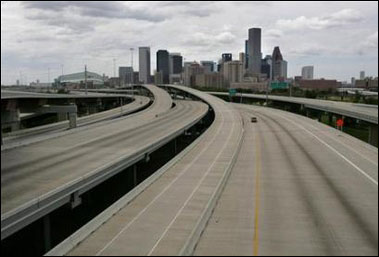|
Hurricane Rita assaults Texas, Louisiana by Erwin Seba
(Reuters)
Updated: 2005-09-24 15:06
High winds and heavy rains lashed Texas and Louisiana on Saturday as Hurricane Rita crashed in from the Gulf of Mexico with a storm surge that was expected to swamp coastal towns in both states.

An empty highway of Houston is seen after thousands of residents evacuated the city in advance of Hurricane Rita September 23, 2005. Texas officials warned of a catastrophe and water spilled over levees to flood parts of New Orleans anew on Friday as Hurricane Rita barreled toward the U.S. Gulf Coast with winds reaching 135 mph (217 kph). [Reuters] |
|
After sweeping through key offshore oil fields, the powerful storm took aim at the coast's refinery row where much of the nation's gasoline and petrochemicals are produced.
A spectacular fire of unknown origin broke out in Galveston's historical center and quickly engulfed three buildings as firefighters struggled to put the blaze out in 60 mph winds. Burning cinders swirled across the sky and on to the firemen, forcing them to stay well back.
The National Hurricane Center in Miami said at 1 a.m. EDT the center of Rita was 40 miles southeast of Sabine Pass at the Texas-Louisiana border and moving northwest with top winds of 120 mph (193 kmh).
In Port Arthur and Beaumont in southeastern Texas and Lake Charles, Louisiana, 60 miles to the east, trees toppled in the rising winds and streets were littered with blowing debris.
The storm's projected path reminded many of Hurricane Audrey, which inundated southwestern Louisiana in 1957, killing at least 390 people.
"It's just like Audrey. I was 9 years old and it was terrible," said Phillis Carbalan of Lake Charles.
In the island city of Galveston, 50 miles south of Houston, high winds knocked out power to most of the city, shoved over street signs and caused utility poles to sway back and forth. Minor flooding was reported in parts of the city.
Houston, the nation's fourth largest city, was getting gusty winds and intermittent rains but did not take a direct blow from Rita.
Forecasters predicted a 15- to 20-foot storm surge would spill over local levees in the low-lying coastal region.
"This will bring Gulf waters as far north as the Interstate 10 (highway) corridor from Beaumont to Lake Charles," the weather service said.
Port Arthur, a refinery town right on the Texas-Louisiana border, was expected to get severe flooding, they said.
Rita was the second powerful hurricane to strike the Gulf Coast in less than a month, following Katrina, which devastated southeastern Louisiana, including the historic city of New Orleans, and Mississippi, killing at least 1,069 people.
Together, the two storms knocked out nearly all energy production in the Gulf and 30 percent of the nation's refining capacity.
The oil industry was anxiously waiting to see whether major refineries in Lake Charles, Beaumont, Port Arthur and Houston would be damaged by Rita.
While grim-face officials warned that Rita could strike a catastrophic blow, in Galveston's Poop Deck bar overlooking the Gulf the mood was light as bar-goers drank and watched the roiling surf.
"Mother Nature must be a Yankee lady," said personal chef Samantha Gallion. "It's like she's angry at the southern coast. She's hit us all now."
"I'm joking in the face of disaster, she said.
Most of the storm area was devoid of people after more than 2 million fled the area in a mass evacuation that turned chaotic in Texas.
Traffic jams 100 miles long clogged highways leading out of Houston, stranding thousands of motorists who ran out of gas as they inched along for hours on roads headed inland.
The chaos turned into disaster on Friday when a bus carrying residents of a Houston nursing home exploded near Dallas, killing 24 people. Oxygen tanks used by many of the victims exploded in the fire and turned the bus into a charred hulk.
Even though Rita hit 200 miles to the west of New Orleans, the scarred city felt the effects when high tides from the storm spilled over the city's fractured levee system.
In scenes eerily reminiscent of the days after Katrina struck on August 29, water from the city's industrial canal filled up streets in the Ninth Ward and St. Bernard Parish where nearly all the homes are already ruined.
|